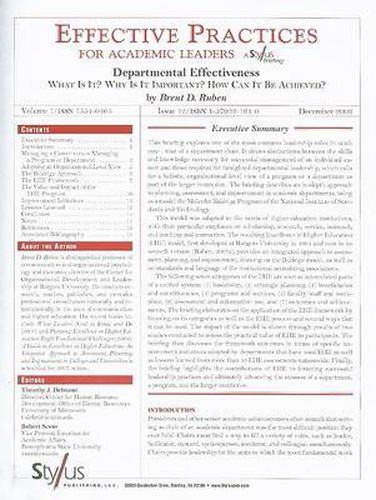Readings Newsletter
Become a Readings Member to make your shopping experience even easier.
Sign in or sign up for free!
You’re not far away from qualifying for FREE standard shipping within Australia
You’ve qualified for FREE standard shipping within Australia
The cart is loading…






Executive Summary This briefing explores one of the most common leadership roles in academe– that of a department chair. It draws distinctions between the skills and knowledge necessary for successful management of an individual career and those required for farsighted departmental leadership, which calls for a holistic, organizational-level view of a program or a department as part of the larger institution. The briefing describes an in-depth approach to planning, assessment, and improvement in academic departments, using as a model the Malcolm Baldrige Program of the National Institute of Standards and Technology.
This model was adapted to the needs of higher-education institutions,
with their particular emphases on scholarship, research, service, outreach, and teaching and instruction. The resulting Excellence in Higher Education (EHE) model, first developed at Rutgers University in 1994 and now in its seventh version (Ruben, 2007a), provides an integrated approach to assessment, planning, and improvement, drawing on the Baldrige model, as well as on standards and language of the institutional accrediting associations.
The following seven categories of the EHE are seen as interrelated parts of a unified system: (1) leadership, (2) strategic planning, (3) beneficiaries and constituencies, (4) programs and services, (5) faculty/staff and workplace, (6) assessment and information use, and (7) outcomes and achievements. The briefing elaborates on the application of the EHE framework by focusing on its categories as well as the EHE process and several ways that it can be used. The impact of the model is shown through results of two studies conducted to assess the practical value of EHE to participants. The briefing then discusses the framework outcomes in terms of specific improvement initiatives adopted by departments that have used EHE as well as lessons learned from more than 50 EHE assessments nationwide. Finally, the briefing highlights the contributions of EHE to fostering successful leadership practices and ultimately advancing the mission of a department, a program, and the larger institution.
$9.00 standard shipping within Australia
FREE standard shipping within Australia for orders over $100.00
Express & International shipping calculated at checkout
Executive Summary This briefing explores one of the most common leadership roles in academe– that of a department chair. It draws distinctions between the skills and knowledge necessary for successful management of an individual career and those required for farsighted departmental leadership, which calls for a holistic, organizational-level view of a program or a department as part of the larger institution. The briefing describes an in-depth approach to planning, assessment, and improvement in academic departments, using as a model the Malcolm Baldrige Program of the National Institute of Standards and Technology.
This model was adapted to the needs of higher-education institutions,
with their particular emphases on scholarship, research, service, outreach, and teaching and instruction. The resulting Excellence in Higher Education (EHE) model, first developed at Rutgers University in 1994 and now in its seventh version (Ruben, 2007a), provides an integrated approach to assessment, planning, and improvement, drawing on the Baldrige model, as well as on standards and language of the institutional accrediting associations.
The following seven categories of the EHE are seen as interrelated parts of a unified system: (1) leadership, (2) strategic planning, (3) beneficiaries and constituencies, (4) programs and services, (5) faculty/staff and workplace, (6) assessment and information use, and (7) outcomes and achievements. The briefing elaborates on the application of the EHE framework by focusing on its categories as well as the EHE process and several ways that it can be used. The impact of the model is shown through results of two studies conducted to assess the practical value of EHE to participants. The briefing then discusses the framework outcomes in terms of specific improvement initiatives adopted by departments that have used EHE as well as lessons learned from more than 50 EHE assessments nationwide. Finally, the briefing highlights the contributions of EHE to fostering successful leadership practices and ultimately advancing the mission of a department, a program, and the larger institution.